Coronavirus Today: Is a COVID-19 pill finally on the horizon?
Merck said its pill to treat COVID-19 in newly infected patients cut deaths and hospitalizations by half. — Good evening. I’m Karen Kaplan, and it’s Friday, Oct. 1. Here’s the latest on what’s happening with the coronavirus in California and beyond.
Dear readers, meet molnupiravir. This little red pill has the potential to change the course of the pandemic.
Molnupiravir is an antiviral medication developed by Merck and Ridgeback Biotherapeutics. It is designed to disrupt the coronavirus’ ability to replicate itself inside of human cells.
Essentially, the drug tricks the virus into using its recipe for replication, then inserts a program that generates so many mutations that the virus quickly sputters and dies. Clever, huh?
This strategy of inducing “lethal mutagenesis” appears to work not only on the coronavirus that causes COVID-19 but also on other coronaviruses that plague humankind with respiratory illnesses ranging from the common cold to deadly pneumonias. (It has also been shown to hobble alpha viruses that cause equine encephalitis, the Ebola virus and others.)
Merck tested molnupiravir in 775 adults newly diagnosed with COVID-19 who were considered to be at higher risk for severe disease because they had underlying health problems or were over 60 years of age. Participants took eight pills a day for five days, though they didn’t know whether they got the experimental drug or a placebo.
Among those taking molnupiravir, 7.3% were either hospitalized or died at the end of 30 days. That compares with 14.1% of the 377 patients who got the dummy pill.
Importantly, there were no deaths in the drug group during the study period, compared with eight deaths in the placebo group, the companies said.
In other words, the experimental pill cut rates of severe disease and death in half for this group of patients.
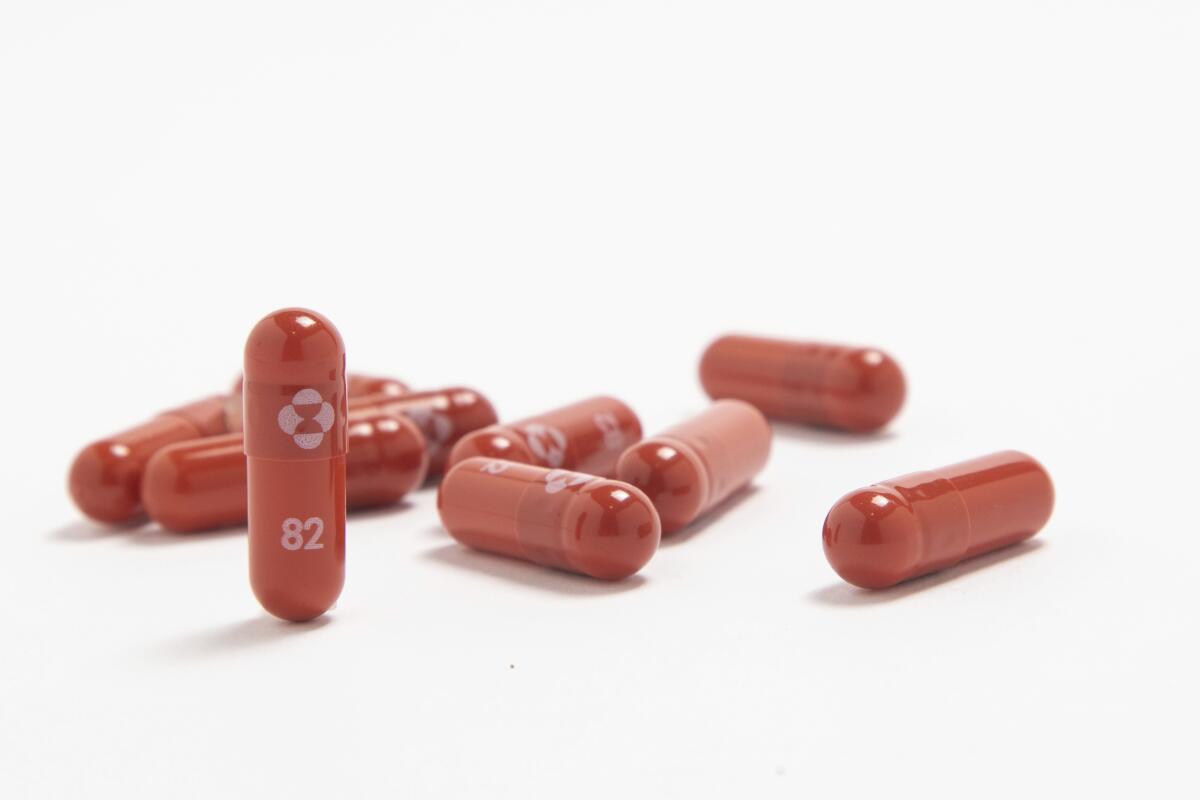
The results were so strong that an independent group of medical experts monitoring the trial recommended stopping it early so the companies could move forward with an application for emergency use authorization.
Merck and Ridgeback said they would file with the U.S. Food and Drug Administration “as soon as possible,” and if all goes well, millions of Americans could be treating themselves at home by the end of the year.
“Nothing is as easy as giving people a prescription to take home, so I think it has extraordinary potential,” Dr. Jeanne Marrazzo, who directs the infectious diseases division at the University of Alabama School of Medicine in Birmingham, told my colleague Melissa Healy.
Pills like the malaria drug hydroxychloriquine and the anti-parasitic medication ivermectin seem to hold special appeal among the unvaccinated, Marrazzo added. With so many patients clinging to treatments that have no track record of helping, “it would be my prayer” to have one that had been shown safe and effective, she said.
The red pills could plug a yawning gap between prevention strategies — masking, social distancing and vaccination — and currently available treatments, all of which require skilled medical care and costly facilities to deliver.
By the numbers
California cases and deaths as of 3:35 p.m. Friday:

Track California’s coronavirus spread and vaccination efforts — including the latest numbers and how they break down — with our graphics.
The NBA’s anti-vaxxers
Imagine you played in a weekend basketball league and your team needed a new coach. Would you head to a doctor’s office or visit the Centers for Disease Control and Prevention to find a replacement? Of course not.
By the same token, if you’re looking for factual information about COVID-19 vaccines, your probably wouldn’t make Kyrie Irving your first stop. Yet the views of the Brooklyn Nets All-Star have gotten more visibility over the past week than anyone else’s.
Irving hasn’t come right out and disparaged the vaccines, which have been administered to billions of people around the world. But when the Nets opened their training camp in New York City on Monday without him, the clear implication was that he wasn’t among the nearly 70% of U.S. adults who are fully vaccinated.
Over the weekend, Rolling Stone published a story suggesting that Irving has bought into an unfounded conspiracy theory that the vaccines are part of a plot by “secret societies” to connect Black people to a master computer and carry out “a plan of Satan.” Irving has been following and liking Instagram posts from an account promoting the theory, the magazine said.
When he joined the Nets’ media day activities Monday via Zoom, he declined to get specific about his vaccination status.
“I would just love to keep that private and handle it the right way with my team and go forward together with a plan,” he said. “Obviously, I’m not able to be present there today. But that doesn’t mean I’m putting any limits on the future on my being able to join the team. And I just want to keep it that way.”
NBA officials say 90% of players are vaccinated, and they expect at least half of the league’s 30 teams to be 100% vaccinated by opening night on Oct. 19. NBA spokesman Mike Bass said the league would like to implement a vaccine mandate for players, but their union would have to agree — and it hasn’t.
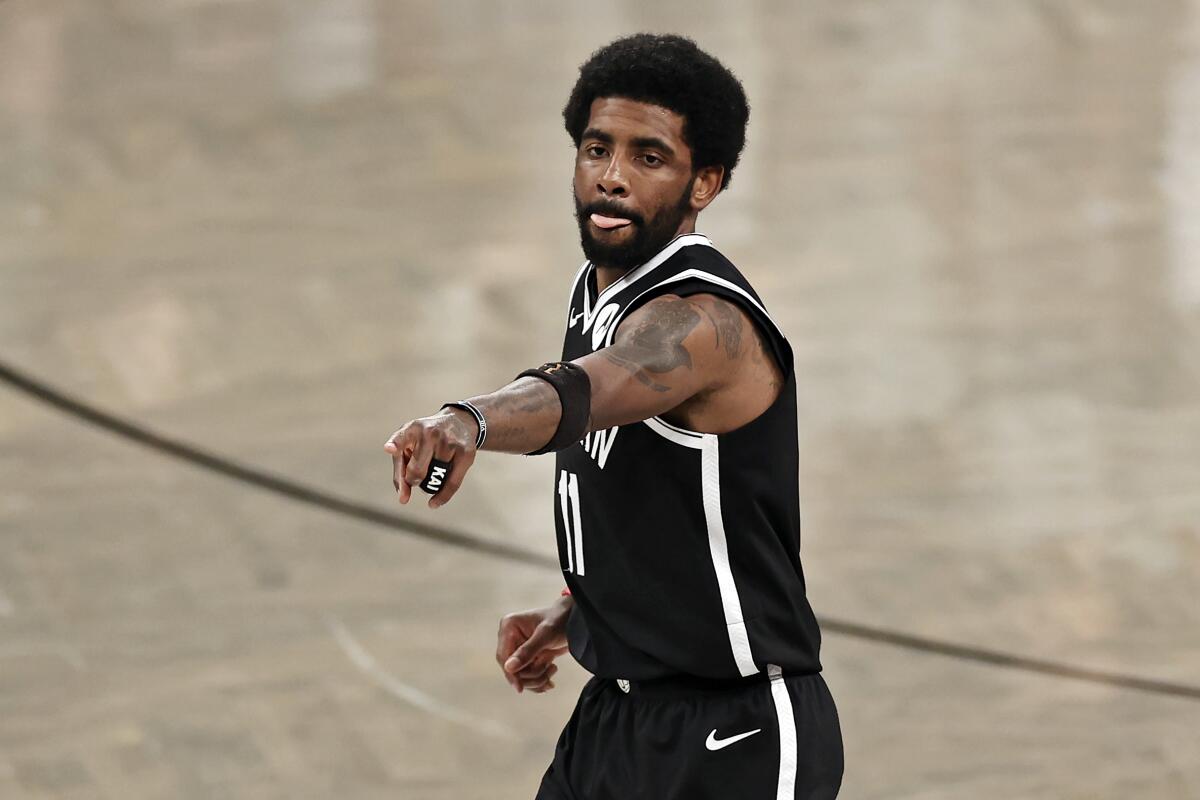
So the focus has shifted to the 10% of players who are holding out. In addition to Irving, that group includes Washington Wizards star Bradley Beal, who came down with COVID-19 this summer — costing him a spot on the U.S. Olympic basketball team — and said plainly that he is not vaccinated. Beal’s objections seemed centered on concerns that the shots aren’t all that effective since people can become infected even after getting vaccinated. (Never mind that the overwhelming majority of people hospitalized with COVID-19 are unvaccinated.)
There’s also Andrew Wiggins of the Golden State Warriors, who said not getting the vaccine is doing what’s “right.” The Warriors play their home games in San Francisco, which is a problem for Wiggins since the city requires people who are 12 and older to be vaccinated if they want to attend large indoor events. Wiggins applied for a religious exemption so that he could play anyway, but the league denied his request.
The NBA has tried to incentivize players to get vaccinated by instituting a more permissive set of protocols for those who’ve had the shots. For instance, they can sit together in locker rooms, restaurants and on planes and busses, and they don’t need to get tested unless they have COVID-19 symptoms.
Unvaccinated players, on the other hand, must be tested any day they travel or practice with their team, and they could be tested more than once on game days. They also have to stick with social distancing and, in accordance with CDC guidelines, they need to quarantine for a week if they’re exposed to someone with a confirmed coronavirus infection, even if they keep testing negative themselves.
This might be the motivation to get vaccinated: “Any player who elects not to comply with local vaccination mandates will not be paid for games that he misses,” Bass said.
It’s not too late for minds to be changed. Kent Bazemore, a newly signed member of the Los Angeles Lakers, said he came around after a conversation with general manager Rob Pelinka.
“When the vaccine first came out, I felt like it was kind of forced on me, and I’m not a person who responds well to that,” Bazemore said. “But I had a good call with Rob Pelinka, and he laid it down to me in the most fairly honest way that I ever heard.”
Pelinka has vowed that every single Laker will be vaccinated when the season kicks off. On the team’s media day, player after player acknowledged their vaccination status — including superstar LeBron James.
“I know that I was very skeptical about it all,” James said. “But after doing my research and things of that nature, I felt like it was best suited, not only for me but for my family and my friends. And that’s why I decided to do it.”
California’s vaccination progress
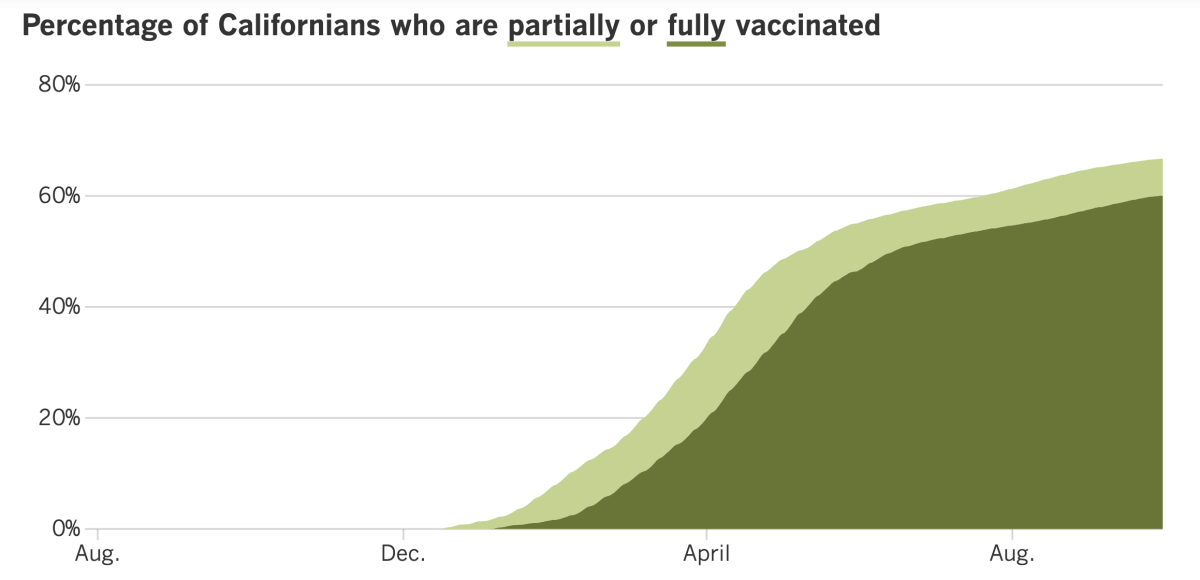
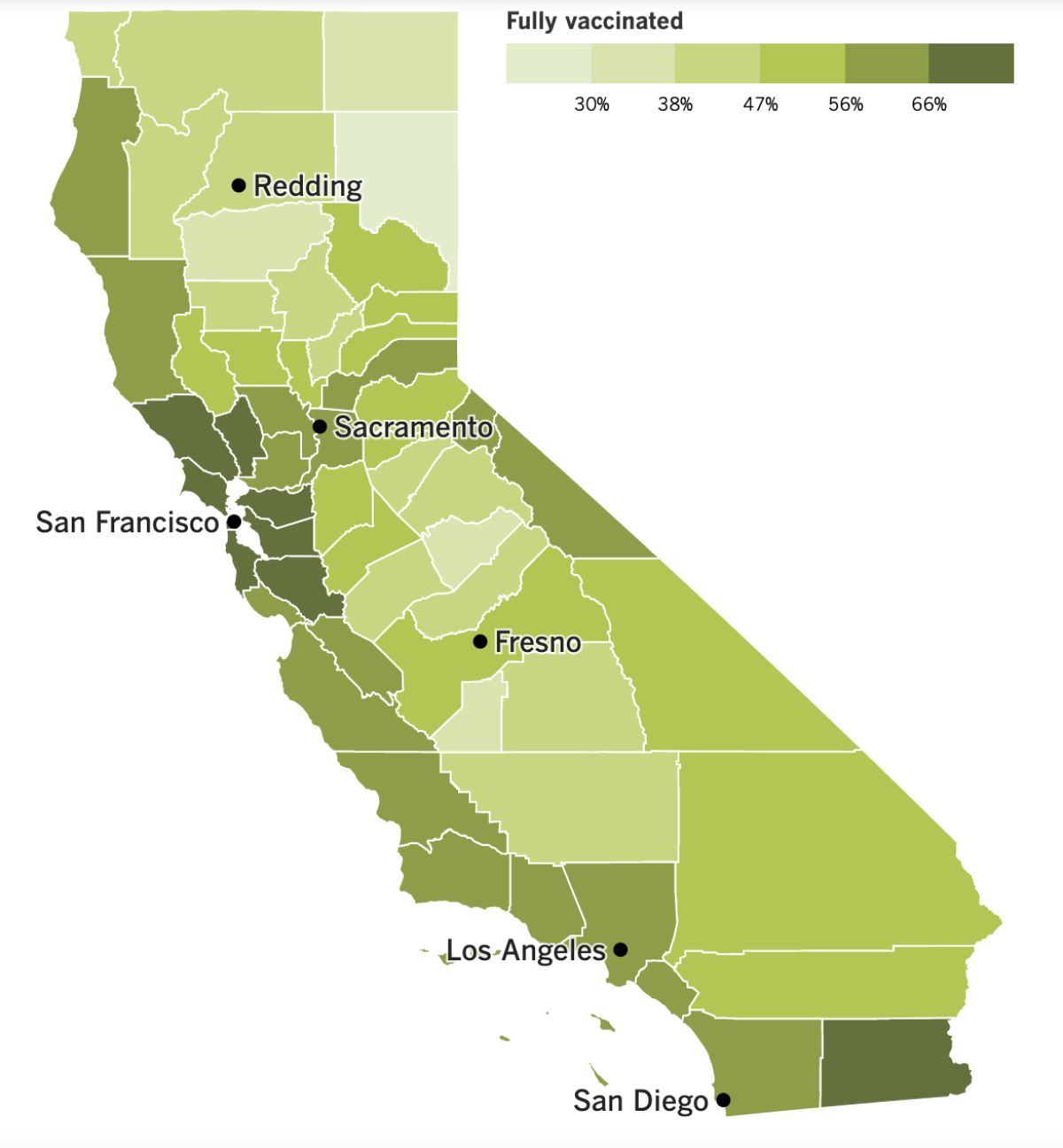
See the latest on California’s vaccination progress with our tracker.
Your support helps us deliver the news that matters most.
In other news ...
California continues to have the lowest level of coronavirus transmission among the 50 states, and Gov. Gavin Newsom seems determined to keep it that way. On Friday, he issued the nation’s first statewide mandate requiring students to be vaccinated against COVID-19.
The mandate will cover millions of primary and secondary students in both public and private schools. It will take effect for students in seventh through 12th grades once a vaccine receives full FDA approval for children ages 12 and up. Students in kindergarten through sixth grade would be phased in later.
Once the mandate is in place, the COVID-19 vaccine would be treated like vaccines for measles, whooping cough, diphtheria, polio and other contagious diseases. Children who don’t get it would be barred from attending class on campus, unless they have a medical or religious exemption.
The FDA has already granted full approval to Comirnaty, the vaccine from Pfizer and BioNTech, for use in people 16 and older. The same vaccine is currently available to adolescents ages 12 to 15 through an emergency use authorization; that could be upgraded to full approval as early as January, Newsom said.
Younger students would be subject to the mandate after a vaccine is formally approved for younger children. Pfizer has said it will soon seek emergency use authorization for a version of its vaccine designed for children ages 5 to 11, and experts believe it could be available around Thanksgiving. It’s not clear how much longer it would take to receive full approval.
Moderna and Johnson & Johnson are also working on COVID-19 vaccines for children and teens.
Thursday was the deadline for around 2.4 million healthcare workers in California to be vaccinated or risk losing their jobs under a previous statewide mandate. It appears that the overwhelming majority of workers have complied, but thousands still remain unvaccinated.
Some of these holdouts obtained exemptions on medical or religious grounds. The state did not set rules for evaluating such requests, allowing some employers to be more permissive than others.
Scripps Health in San Diego allowed employees who were pregnant to delay their vaccinations as long as they got them when they returned to work after their parental leave. But in Visalia, the Kaweah Health Medical Center granted every one of the more than 800 religious exemption requests it received; any other approach could have left the hospital massively short-staffed, said Chief Executive Gary Herbst.
Visalia is in Tulare County, where the vaccination rate is just 43.3% and hospitals are straining to treat COVID-19 patients. “We cannot afford to lose a single nurse,” Herbst said.
Unvaccinated workers without exemptions present a significant test for employers. Some hospitals said they planned to start firing recalcitrant workers on Friday. Others said they would begin with suspensions or offer grace periods to give workers one more chance to come around. Most doctors were vaccinated months ago, but the inoculation rate lagged among nurses, janitors, food service workers and other hospital employees.
It’s been about three weeks since President Biden said he would require most workers across the country to either get vaccinated or undergo regular coronavirus testing. A new poll found that 51% of those surveyed endorsed the vaccine mandate, while 34% disapproved and 14% were neutral.
Unsurprisingly, the responses revealed a deep partisan divide. While 72% of Democrats supported the mandate, just 27% of Republicans shared that view. On the flip side, 62% of Republicans opposed it, along with 11% of Democrats.
About two-thirds of those questioned said they were at least somewhat worried about the prospect that they or a family member would catch the coronavirus. However, the proportion of people expressing intense worry declined, from 41% in August to 33% in September.
Overall, 57% of Americans said they approved of Biden’s handling of the pandemic — including 86% of Democrats, 50% of independents and 23% of Republicans. Biden’s overall pandemic approval was 54% in August and 66% in July.
Social media platforms have endured months of criticism for facilitating the spread of misinformation about COVID-19 vaccines, and YouTube responded Wednesday with a promise to ban it.
The new rules prohibit false claims about any vaccine that has been OK’d by health authorities and is currently being administered. Videos that violate the rules — for instance, by claiming that vaccines cause cancer, autism or are otherwise dangerous — will be deleted. Some have been kicked off already, including an account run by prominent anti-vaxxer Robert F. Kennedy Jr.
YouTube will not police claims about vaccines that are still being tested. Nor will it remove personal stories about vaccine reactions, unless they come from accounts with a track record of spreading misinformation.
Here’s something that’s absolutely true: Supreme Court Justice Brett Kavanaugh has tested positive for a coronavirus infection. The 54-year-old jurist is vaccinated and has no symptoms, the court said Friday.
Kavanaugh is not the first member of the high court to test positive — Amy Coney Barrett had COVID-19 last year, before she joined the court. (The Rose Garden ceremony where her nomination was announced turned the White House into a coronavirus hot spot.) But he is the first sitting justice to report an infection.
All nine justices were tested for the virus Thursday in advance of Barrett’s ceremonial swearing-in. Kavanaugh skipped the event after receiving his results. He — along with the other members of the court — tested negative before a meeting on Monday to discuss cases they might add to their docket.
The high court’s new term begins Monday, and it will mark the first time in 18 months that the justices will return to the courtroom. It’s unclear whether Kavanaugh will join them. The CDC recommends that people without symptoms isolate for 10 days after a positive test result.
Here’s a final note from the Department of Silver Linings: Pandemic-related school closures are being credited with a huge drop in vaping among U.S. teens.
A national survey by researchers at the CDC and FDA found that 11% of high school students said they were recent users of e-cigarettes and other vaping products, down from 20% the year before. In addition, 3% of middle school students said they had vaped recently, down from 5% a year earlier.
This year’s survey was conducted online for the first time, and that may have affected the results, U.S. health officials cautioned. But other experts said the decline made sense since teens often vaped in social situations — which they were deprived of while the pandemic forced them to stay home.
“It’s hard to imagine that doesn’t represent a real decrease in use among high school and middle school students,” said Dr. Nancy Rigotti of Harvard University, who studies tobacco use.
Your questions answered
Today’s question comes from readers who want to know: Is the Delta variant worse for kids than previous versions of the coronavirus?
If by “worse” you mean “makes kids sicker,” then the answer is no. Scientists and epidemiologists have seen no strong evidence that children and teens infected with Delta develop more serious cases of COVID-19 than their peers infected with other coronavirus strains.
But if by “worse” you mean “makes more kids sicker,” then the answer is yes. Since the Delta variant is more transmissible, the number of children and teens catching is higher than in the past.
More than 5.7 million children in the U.S. have tested positive for coronavirus infections since the pandemic began, according to the American Academy of Pediatrics and the Children’s Hospital Assn.
The number of newly diagnosed children has topped 200,000 per week for the past five weeks — a figure the organizations deem “exceptionally high.” For much of September, the weekly number of new pediatric cases exceeded the peak from the winter surge.
Thankfully, most of those cases have been mild, and among infected children, the COVID-19 hospitalization rate has held steady at just under 1%.
We want to hear from you. Email us your coronavirus questions, and we’ll do our best to answer them. Wondering if your question’s already been answered? Check out our archive here.
The pandemic in pictures
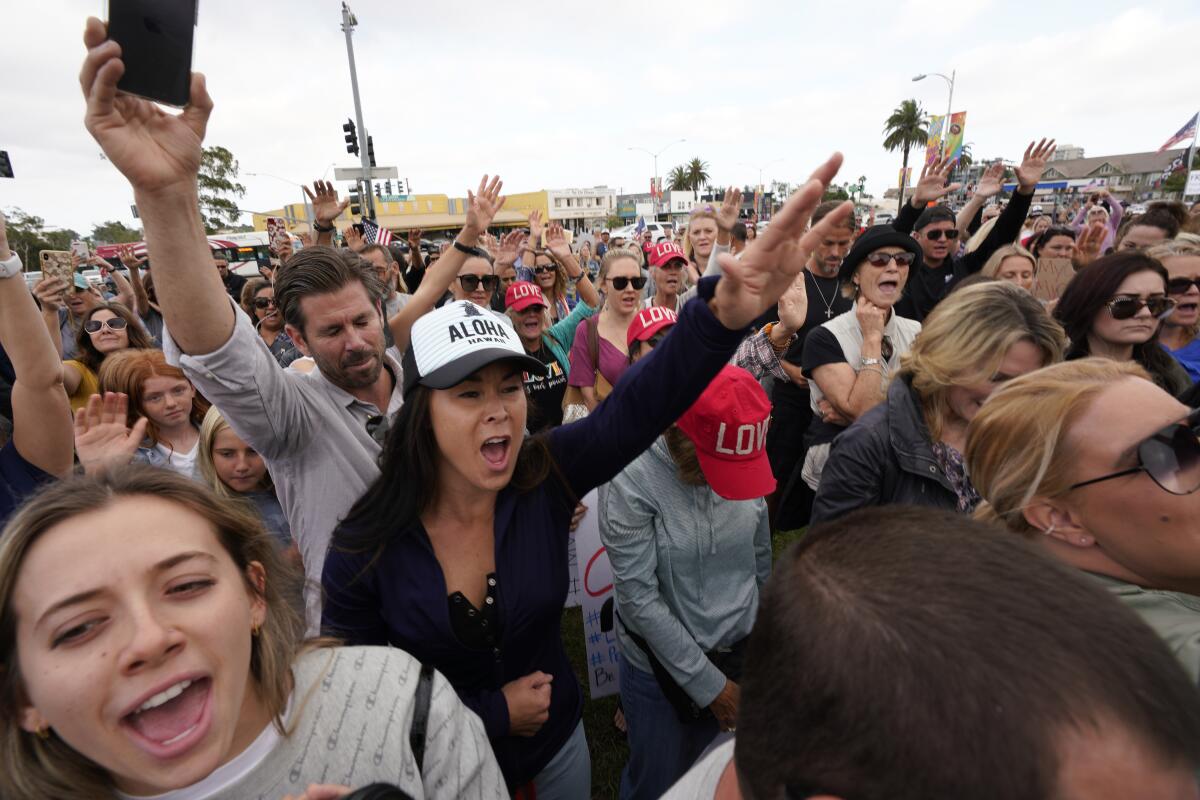
Americans may be tired of the pandemic, but we’re definitely not tired of protesting pandemic-related restrictions.
The photo above was taken outside the headquarters of the San Diego Unified School District on Tuesday as school board members considered a proposal to require students ages 16 and up to be vaccinated against COVID-19.
Parents, teachers, students and medical professionals inside the meeting room discussed facts: Children can get sick with COVID-19, and the odds of that happening are far greater if they don’t have the protection of a vaccine. But those truths held little sway for the hundreds of people who showed up to protest — and stood extremely close together with hardly a mask in sight. Some carried signs broadcasting misinformation about COVID-19 vaccines and the disease itself.
The school board members were undeterred. They approved the vaccine mandate in a unanimous vote two days before Newsom announced his statewide order.
“Tonight we’re making a statement that we believe in the science,” said school board Vice President Sharon Whitehurst-Payne.
A more colorful endorsement came from Mica Pollock, parent of a student at San Diego High: “The FDA-approved vaccination is the best that human science has to offer,” she said. “If you don’t trust it, you shouldn’t get medical care of any kind from humans trained in science.”
Resources
Need a vaccine? Keep in mind that supplies are limited, and getting one can be a challenge. Sign up for email updates, check your eligibility and, if you’re eligible, make an appointment where you live: City of Los Angeles | Los Angeles County | Kern County | Orange County | Riverside County | San Bernardino County | San Diego County | San Luis Obispo County | Santa Barbara County | Ventura County
Practice social distancing using these tips, and wear a mask or two.
Watch for symptoms such as fever, cough, shortness of breath, chills, shaking with chills, muscle pain, headache, sore throat and loss of taste or smell. Here’s what to look for and when.
Need to get tested? Here’s where you can in L.A. County and around California.
Americans are hurting in many ways. We have advice for helping kids cope, resources for people experiencing domestic abuse and a newsletter to help you make ends meet.
We’ve answered hundreds of readers’ questions. Explore them in our archive here.
For our most up-to-date coverage, visit our homepage and our Health section, get our breaking news alerts, and follow us on Twitter and Instagram.




